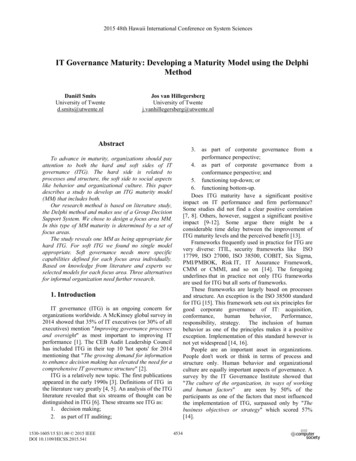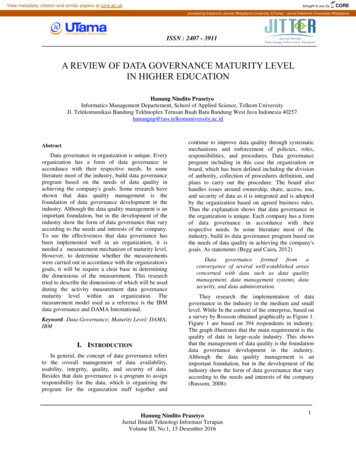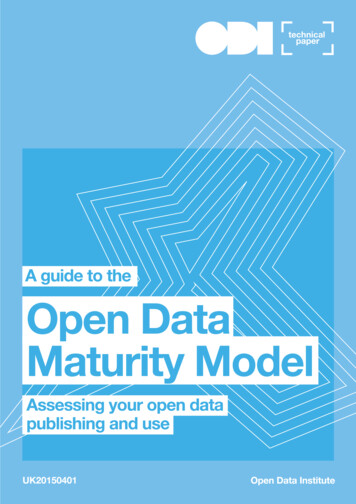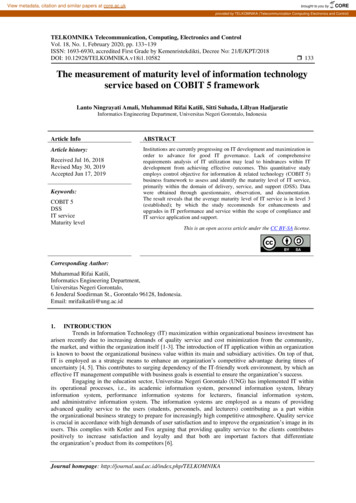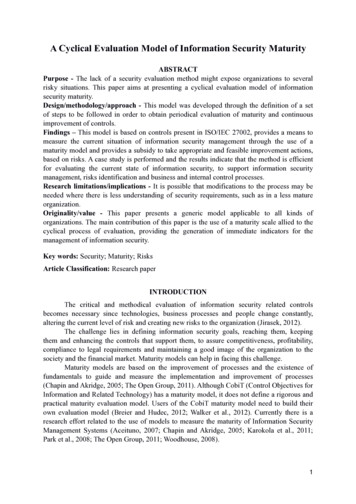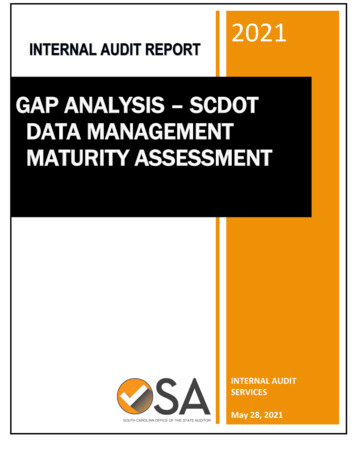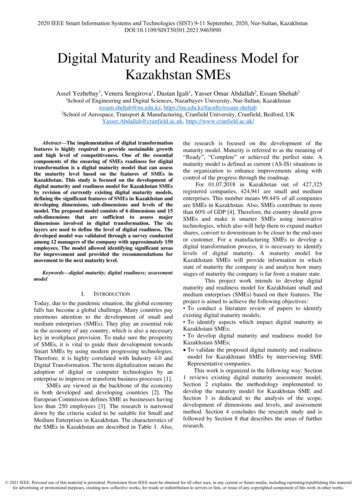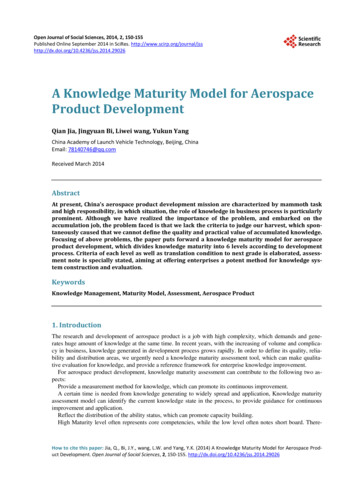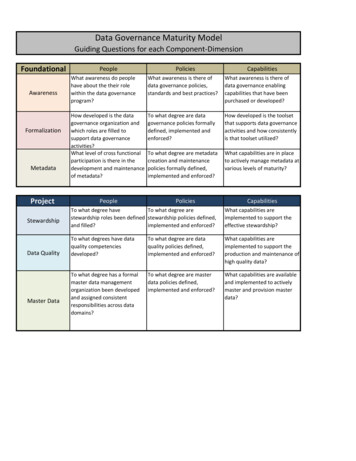
Transcription
Data Governance Maturity ModelGuiding Questions for each ionMetadataProjectStewardshipData QualityMaster DataPeoplePoliciesCapabilitiesWhat awareness do peoplehave about the their rolewithin the data governanceprogram?What awareness is there ofdata governance policies,standards and best practices?What awareness is there ofdata governance enablingcapabilities that have beenpurchased or developed?How developed is the datagovernance organization andwhich roles are filled tosupport data governanceactivities?What level of cross functionalparticipation is there in thedevelopment and maintenanceof metadata?To what degree are datagovernance policies formallydefined, implemented andenforced?How developed is the toolsetthat supports data governanceactivities and how consistentlyis that toolset utilized?To what degree are metadatacreation and maintenancepolicies formally defined,implemented and enforced?What capabilities are in placeto actively manage metadata atvarious levels of maturity?PeoplePoliciesCapabilitiesTo what degree haveTo what degree arestewardship roles been defined stewardship policies defined,and filled?implemented and enforced?What capabilities areimplemented to support theeffective stewardship?To what degrees have dataquality competenciesdeveloped?To what degree are dataquality policies defined,implemented and enforced?What capabilities areimplemented to support theproduction and maintenance ofhigh quality data?To what degree has a formalmaster data managementorganization been developedand assigned consistentresponsibilities across datadomains?To what degree are masterdata policies defined,implemented and enforced?What capabilities are availableand implemented to activelymaster and provision masterdata?
Data Governance Foundational Component MaturityAwarenessPoliciesMost existing datapolicies areundocumented andLimited awareness ofthere may be1 purpose or value of DatainconsistentGovernance program.understanding of datapolicies within adepartment.Maturity data isinconsistently collectedand rarely consolidatedoutside of projectartifacts.There is little awarenessof data governancecapabilities andtechnologies.There are no defined1 roles related to datagovernance.AS roles responsible forproduction of technical2 metadata on structureddata are defined duringsystem design.Metadata best practicesare produced and madeavailable. Most bestpractices are focused onthe metadata associatedwith structured data.Metadata templates areadopted to provide someconsistency in contentand format of capturedmetadata. Metadata isconsolidated andavailable from a singleportal. Capabilities focuson capture of metadataof structured content.Home-grown technicalsolutions are adopted asbest practices for someclasses of capabilitiesand made availablethroughout theinstitution.The responsibility fordeveloping institutionalbusiness definitions andstoring them in a central3repository is assigned toand continuallyperformed by subjectmatter experts.Policies requiring thedevelopment of newmetadata as part ofsystem development(usually focused onstructured data) areadopted as officialStanford data policies.The collection ofmetadata on structuredcontent is automatedand scheduled extractsare performed forselected systems.All defined classes datagovernance capabilitieshave an availablesolution.Policies requiring theregular auditing ofMetadatametadata in specifiedcollection/validationsystems are adopted as4 responsibilities assigned official Stanford datato named individuals for policies and metadataall projects.development as part ofsystem development isenforced.A centralized metadatastore becomes theprimary location for allinstitutional metadata.Metadata isautomatically collectedfrom most RDBMS andvendor packagedsystems.A dedicated metadatamanagement group iscreated to strategically5 advance metadatacapabilities and moreeffectively leverageexisting metadata.A metadata solutionprovides a single point ofaccess to federatedmetadata resourcesincluding both structuredand unstructured data.No formal datagovernance policies.Classes of datagovernance capabilitiesare not defined.Executives are aware ofexistence of program.2 Little knowledge ofprogram outside uppermanagement.Existing policies aredocumented but notconsistently maintained,available or consistentbetween departments.A small subset of theorganizationunderstands the generalclasses of datagovernance capabilitiesand technologies.Classes of datagovernance capabilitiesData governance rolesHigh-level dataare defined and homeand responsibilities have governance meta2grown technicalbeen defined and vetted policies are defined andsolutions are used withinwith program sponsors. distributed.some institutionalfunctions.Executives understandhow programbenefits/impacts theirportion of theorganization, knowledge3workers are aware ofprogram. Executivesactively promoteprogram within theirgroups.Common institutionaldata policies aredocumented andavailable through acommon portal. Moststakeholders are awareof existence of datapolicies that may impactthem.A small subset of theorganization is aware ofthe specific datagovernance capabilitiesthat are available atStanford.Some roles are filled tosupport data governanceneeds and participants3 clearly understandresponsibilitiesassociated with theirroles.Data policies becomeofficial Stanford datapolices and compliancewith approved datapolicies is audited.All defined classes ofCompliance with officialdata governanceStanford data policies iscapabilities areactively enforced by amandatory for assignedgoverning body.systems or critical data.Executives understandlong-term programstrategy and their part init. Knowledge workersunderstand how theprogram4impacts/benefits theirportion of theorganization. Executivesactively promoteprogram beyond theimmediate group.All data policies areavailable though acommon portal andstakeholders are activelynotified wheneverpolicies are added,updated or modified.A targeted audience hasbeen identified and asignificant portion ofthat audience is aware ofthe data governancecapabilities that areavailable at Stanford.Data governance rolesare organized intoreusable schemas whichare designed to supportspecific data and4 functionalcharacteristics. There isbroad (but inconsistent)participation in DataGovernanceOrganization.Both executives andknowledge workersunderstand their role inthe long-term evolution5of the program.Knowledge workersactively promoteprogram.A history of all datapolicies are maintainedthrough a commonportal and allstakeholders are madepart of the policydevelopment processthrough onlinecollaborative tools.A significant portion ofthe targeted audienceunderstands how toutilize relevant datagovernance capabilitiesthat are available atStanford.Data governanceorganizational schemas5 are filled as defined,meet regularly anddocument activities.Data policies around thegovernance of specificdata are defined anddistributed as bestpractices.Limited understanding ofNo metadata related1 types and value ofpoliciesmetadata.Metadata policy coversboth structured andunstructured (nontabular) data and isenforced.
Data Governance Project Component MaturityPeopleStewardshipPoliciesAlmost no well defineddata governance orstewardship roles orLimited stewardship1 responsibilities. Datapolicies documented.requirements are drivenby the applicationdevelopment team.Maturity LevelBusiness analysts drivedata requirementsduring design process.2Definition of stewardshiproles and responsibilitiesis limited.Policies aroundstewardship definedwithin a functional areaor subject area.CapabilitiesPeopleData QualityPoliciesCapabilitiesPeopleMaster dataPoliciesCapabilitiesLimited stewardshipcapabilities are available.Individuals perform adhoc data quality effortsas needed and manuallyfix data identified data1issues. Identification ofdata issues is based offof its usability for aspecific business task.Data quality efforts areinfrequent and driven byData quality is done onspecific business needs.ad hoc basis usuallyThese efforts are usuallyusing SQL and Excel.large one-time datacleansing efforts.Inconsistentunderstanding of1 concepts and benefits ofMaster DataManagement.No formal policiesdefining what data isconsidered institutionalmaster data.There is limitedmanagement of masterdata.A centralized locationexists for consolidationof and/or access tostewardship relateddocumentation.A small group ofindividuals are trained inand perform profiling toassess data quality ofexisting systems to2 establish a baseline orjustify a data qualityproject. Down streamusage of the data isconsidered in issueidentification process.Best practices have beendefined for some dataquality related activitiesand followedinconsistently.Basic data profiling toolsare adopted andavailable for useanywhere in the systemdevelopment lifecycle.Stakeholders for specificmaster data domains areidentified and consulted2to develop basicdefinition and model ofmaster data.Institutional master datadomains are defined andthe systems storingmaster data and isdocumented. Usage ofmaster data in thesesystems is actively beingdocumented.Master data areidentified and manuallymanaged andprovisioned via extracts,file transfers or manualuploads.Profiling anddevelopment of dataquality standards arePeople are assigned toadopted as part of theassess and ensure data3standard applicationquality within the scopedevelopment lifecycleof each project.and become scheduledactivities on projectplans.Data quality reportingcapabilities areimplemented andavailable to any Stanfordsystem.Owners of institutionalmaster data areidentified and driveresolution of variousperspectives of master3data. Owners establishand run master databoards to supportmaintenance and dataissue mediation.Master data areInstitutional master data provisioned throughperspectives resolvedservices butand documented.management capabilitiesare still largely manual.Data quality experts areidentified throughoutthe institution and are4engaged in all dataquality improvementprojects.Data quality bestpractices are adopted asofficial Stanford datapolices.Data quality issueremediation isintegrated into qualityreporting platform.Master DataManagement boardstake responsibility for4 reviewing the use oftheir master data in theapplication developmentprocess.Compliance with masterdata usage policies andstandards is enforced.Synchronizationfrequency with masterdata hub at systemowner's discretion.A data qualitycompetency center isfunded and charged with5 continually assessing andimproving data qualityoutside of the systemdevelopment lifecycle.Data quality remediationis implemented on bothCompliance with officialdata at rest (inStanford data qualitydatabases) and data inpolicies is tracked andflight (in ETL and asreported on centrally.messages betweensystems).Workflow capabilitiesare implemented for theAll stewardship roles and Stewardship policies are vetting and approval ofstructures are definedconsistent betweeninstitutional definition,3and filled but are stillfunctions and subjectbusiness metadata andfunctionally siloed.areas.approval of otherstewardship relateddocumentation.The stewardshipstructures include4 representatives frommultiple businessfunctions.Stewardship dashboardsreport data quality levelsStewardship teams selfand data exceptions toaudit compliance withsupport the auditing ofpolicies.stewardshipeffectiveness.The stewardship boardincludes representatives5 from all relevantinstitutional functionsincluding AS.Compliance withstewardship polices areenforced for keyinstitutional data.A common stewardshipdashboard enablesmanaged issueremediation as part ofdata quality reportingand data exceptionreporting.Master DataManagement boardstake responsibility forCompliance with master5 enforcing master datadata synchronizationpolicies around theirpolicy is enforced.own master data acrossthe institution.Multiple single domainmaster data hubs handleprovisioning andmanagement of masterdata.Multidomain masterdata hub handles allprovisioning andmanagement of masterdata.
Foundational Executives are aware of existence of2 program. Little knowledge ofTraining Sessions*attendeesprogram outside upper management.Existing policies are documented butPolicies documented by functionalnot consistently maintained, availablearea, business subject area.or consistent between departments.A small subset of the organizationunderstands the general classes ofdata governance capabilities andtechnologies.Executives understand how programbenefits/impacts their portion of theorganization, knowledge workers are3Newsletters*recipientsaware of program. Executivesactively promote program withintheir groups.Common institutional data policiesare documented and availablethrough a common portal. Moststakeholders are aware of existenceof data policies that may impactthem.Executives understand long-termprogram strategy and their part in it.Knowledge workers understand howHits on DG website, Unique4 the program impacts/benefits theirvisitors on DG websiteportion of the organization.Executives actively promote programbeyond the immediate group.All data policies are available thougha common portal and stakeholdersNumber of stakeholders in RACIare actively notified whenevermatrices by subject area, functionalpolicies are added, updated orareamodified.A targeted audience has beenidentified and a significant portion ofthat audience is aware of the datagovernance capabilities that areavailable at Stanford.Both executives and knowledgeworkers understand their role in the5 long-term evolution of the program.Knowledge workers actively promoteprogram.A history of all data policies aremaintained through a common portalNon-board participants in policyand all stakeholders are made part ofdevelopmentthe policy development processthrough online collaborative tools.A significant portion of the targetedTraining Sessions on usage of DGaudience understands how to utilizetechnologies and capabilitiesrelevant data governance capabilities(person*tech trained)that are available at Stanford.Limited awareness of purpose orvalue of Data Governance program.People1There are no defined roles related todata governance.Training Sessions on DG capabilitiesand technologiesA small subset of the organization isHits on Policy Management Content, aware of the specific data governanceUnique visitorscapabilities that are available tiesQuantitativeQualitativeQuantitativeClasses of data governancecapabilities are not defined.No formal data governance policies.Classes of data governancecapabilities are defined and homegrown technical solutions are usedwithin some institutional functions.Data governance capabilities withsolutions by functional org. Reuse oftechnical solutions by functional org.Home-grown technical solutions areadopted as best practices for someclasses of capabilities and madeavailable throughout the institution.Capabilities approved as Stanfordrecommended solutions.Data governance roles are organizedinto reusable schemas which areData policies become official Stanforddesigned to support specific data and Boards in compliance withOfficial Data policies approved, data4data polices and compliance withfunctional characteristics. There isdefined schemas, % roles filled.policies with auditapproved data policies is audited.broad (but inconsistent) participationin Data Governance Organization.All defined classes data governancecapabilities have an availablesolution.Usage of standard solutions byproject. Uses of non-standardsolutions by projectData governance organizational5 schemas are filled as defined, meetregularly and document activities.All defined classes of datagovernance capabilities aremandatory for assigned systems orcritical data.(Lower is better): Uses of nonstandard solutions by project, (Loweris better) no use of solution byproject.Data governance roles and2 responsibilities have been definedand vetted with program sponsors.FormalizationQualitativeThere is little awareness of datagovernance capabilities andtechnologies.Qualitative3Some roles are filled to support datagovernance needs and participantsclearly understand responsibilitiesassociated with their roles.High-level data governance metapolicies are defined and distributed.Participants in approved roles.Meta-policies defined, documentedand approvedData policies around the governance Best Practices/Standards/Policiesof specific data are defined andidentified, documented anddistributed as best practices.approvedCompliance with official StanfordBoard meetings to plan, Minutes(Lower is better) Exceptions todata policies is actively enforced by aproduced.official data policies.governing tiveMost existing data policies areundocumented and there may beinconsistent understanding of datapolicies within a itativeQuantitativeLimited understanding of types and1value of metadata.No metadata related policiesMetadata is inconsistently collectedand rarely consolidated outside ofproject artifacts.AS roles responsible for production of(Lower is better) Projectstechnical metadata on structured2without documented technicaldata are defined during systemmetadata.design.Metadata best practices areproduced and made available. MostBest Practices identified, in progress,best practices are focused on theapproved.metadata associated with structureddata.Metadata templates are adopted toprovide some consistency in contentand format of captured metadata.Metadata entities in portal. Edits byMetadata is consolidated andusers to metadataavailable from a single portal.Capabilities focus on capture ofmetadata of structured content.The responsibility for developinginstitutional business definitions and Unique individuals3 storing them in a central repository is creating/updating metadata.assigned to and continuallyQualitative rating of metadata.performed by subject matter experts.Policies requiring the development ofnew metadata as part of systemdevelopment (usually focused onstructured data) are adopted asofficial Stanford data policies.The collection of metadata onstructured content is automated and Systems with automatic collection ofscheduled extracts are performed for metadata.selected systems.Metadata collection/validation4 responsibilities assigned to namedindividuals for all projects.Projects with metadataresponsibility assignmentPolicies requiring the regular auditingof metadata in specified systems areadopted as official Stanford dataSystems with audits in place.policies and metadata development Compliance with policy.as part of system development isenforced.A centralized metadata storebecomes the primary location for allinstitutional metadata. Metadata isautomatically collected from mostRDBMS and vendor packagedsystems.(Lower is better) Systems not loadingto metadata repository.A dedicated metadata managementgroup is created to strategically5 advance metadata capabilities andmore effectively leverage existingmetadata.ROI of Metadata CompetencyCenterMetadata policy covers bothstructured and unstructured (nontabular) data and is enforced.A metadata solution provides a singlepoint of access to federatedmetadata resources including bothstructured and unstructured data.Unstructured objects linked tometadata repository. (Lower isbetter) systems out of compliancewith load SLA.New Metadata entities/elements byproject, metadata reuse. (Lower isbetter) projects without metadatapolicy.Structured Policies/Systems incompliance, UnstructuredPolicies/Objects in compliance.
Project ost no well defined datagovernance or stewardship roles or1 responsibilities. Data requirementsare driven by the applicationdevelopment team.Limited stewardship policiesdocumented.QuantitativeLimited stewardship capabilities areavailable.All stewardship roles and structures3 are defined and filled but are stillfunctionally siloed.Stewards, Participants inStewardship boards,Stewardship board meetings.Workflow capabilities areimplemented for the vetting andStewardship policies are consistentapproval of institutional definition,Institutional Data Entities with policybetween functions and subject areas.business metadata and approval ofother stewardship relateddocumentation.The stewardship structures include4 representatives from multiplebusiness functions.Functional Areas Representedon Stewardship BoardsStewardship teams self-auditcompliance with policies.The stewardship board includes5 representatives from all relevantinstitutional functions including AS.Boards with AS and BusinessRepresentationCompliance with stewardship polices(Lower is better) Key Institutionalare enforced for key institutionalData without stewardship policiesdata.PeopleFunctional areas with policy,Functional Data Entities with policyAudits, Audit ComplianceQualitativeData quality efforts are infrequentand driven by specific business needs. Data Cleansing Efforts identified, inThese efforts are usually large oneprogress, completed.time data cleansing efforts.Individuals trained in profiling,systems profiled, tables profiled,Best practices have been defined forelements profiled. Profilessome data quality related activitiesresulting in recommendations,and followed inconsistently.recommendations spawningprojects.People are assigned to assess and3 ensure data quality within the scopeof each project.Profiling and development of dataProjects with DQ roles assigned.quality standards are adopted as part (Lower is better) Application"DQ fixes" at project level.of the standard applicationdevelopment projects withoutIssues documented anddevelopment lifecycle and becomeprofiling effort.approved.scheduled activities on project plans.Data quality experts are identifiedthroughout the institution and are4engaged in all data qualityimprovement projects.Systems analyzed, tablesanalyzed, elements analyzed.Data quality best practices areRecommendations proposed,adopted as official Stanford dataRecommendations spawning DQ polices.remediation.A data quality competency center isfunded and charged with continuallyROI of DQCC. System Team5 assessing and improving data qualityendorsements.outside of the system developmentlifecycle.PeopleDashboards by function, subjectarea. Qualitative score ondashboard.A common stewardship dashboardenables managed issue remediationas part of data quality reporting anddata exception reporting.Issues reported, Issues resolved,Time to resolution.Data Quality Best Practices defined.QualitativeStakeholders for specific master datadomains are identified and consulted Stakeholders identified,to develop basic definition and model stakeholders' agreement.of master data.QuantitativeData quality is done on ad hoc basisusually using SQL and Excel.Basic data profiling tools are adoptedData Profiles by system, functionaland available for use anywhere in thearea. Rows profiled.system development lifecycle.Data quality reporting capabilities are Systems with data quality reporting,implemented and available to anyapproved elements reported on.Stanford system.Raw Quality Metrics.(Lower is better) Exceptions toofficial data quality policies.QualitativeSystems with data qualityremediation functionality. Issuesresolved.Data quality remediation is(Lower is better) Systems without DQimplemented on both data at rest (inreporting, remediation. Interfacesdatabases) and data in flight (in ETLwithout reporting, remediation.and as messages between systems).PoliciesQuantitativeInconsistent understanding of1 concepts and benefits of Master DataManagement.2Stewardship dashboards report dataquality levels and data exceptions tosupport the auditing of stewardshipeffectiveness.Data quality issue remediation isApproved Stanford DQ Policies, dataintegrated into quality reportingquality policies with auditplatform.Compliance with official Stanforddata quality policies is tracked andreported on centrally.Institutional Definitions throughprocess (completed, in progress)CapabilitiesQuantitativeA small group of individuals aretrained in and perform profiling toassess data quality of existing systems2 to establish a baseline or justify adata quality project. Down streamusage of the data is considered inissue identification process.QualitativeA centralized location exists forCount of policies (by status) inconsolidation of and/or access toregistrystewardship related documentation.PoliciesQuantitativeIndividuals perform ad hoc dataquality efforts as needed and*data quality implies quality inmanually fix data identified data1terms of formally definedissues. Identification of data issues isdefinition of fit-for-use data.based off of its usability for a specificbusiness task.Data QualityQualitativePolicies around stewardship definedwithin a functional area or subjectarea.QualitativeMaster DataCapabilitiesQuantitativeProjects with explicit DataDesign.2StewardshipBusiness analysts drive datarequirements during design process.Definition of stewardship roles andresponsibilities is limited.QualitativeCapabilitiesQuantitativeNo formal policies defining what datais considered institutional masterdata.Institutional master data domains aredefined and the systems storingMaster Data Entities Identified.master data and is documented.Functions consulted. PerspectivesUsage of master data in theseIdentified.systems is actively beingdocumented.QualitativeQuantitativeThere is limited management ofmaster data.Master data are identified andmanually managed and provisionedvia extracts, file transfers or manualuploads.Systems using master data bytransport methodOwners of institutional master dataare identified and drive resolution ofMaster Data Models approved.Master data are provisioned throughvarious perspectives of master data. Approved owners, stakeholders Institutional master data perspectivesSystems using master data via3(Lower is better) distinct perspectives services but management capabilitiesOwners establish and run master data with input.resolved and documented.services.of master data entities.are still largely manual.boards to support maintenance anddata issue mediation.Master Data Management boardstake responsibility for reviewing the4use of their master data in theapplication development process.5Boards taking reviewresponsibility.Master Data Management boardstake responsibility for enforcingBoards taking enforcementmaster data policies around their own responsibility.master data across the institution.Compliance with master data usagepolicies and standards is enforced.Synchronization frequency withmaster data hub at system owner'sdiscretion.Results of audit.Multiple single domain master datahubs handle provisioning andmanagement of master data.Master Data Hubs. Master data hubcapability score.Compliance with master datasynchronization policy is enforced.Results of audit.Multidomain master data hubhandles all provisioning andmanagement of master data.(Lower is better) Master data hubs,master data hub score.
data? Data Governance Maturity Model Guiding Questions for each Component-Dimension. People Policies Capabilities People Policies Capabilities People Policies Capabilities 1 Limited awareness of purpose or value of Data Governance program. Most existing data policies are undocumented and

